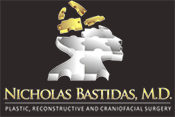Non-Surgical Ear Molding – The Safer Way to Correct Your Infant’s Ear Shape
by Nicholas Bastidas, MD
Like most new parents, you want the best for your child. That includes making sure their ears are shaped correctly! Many infants are born with ear deformities, which can be corrected through ear molding within the first three weeks of life. This process is non-invasive, painless, and covered by insurance.
What is Infant Ear Molding?
Several studies report an increased frequency of infant ear deformities. It consists mainly of prominent and curved ears with sticking edges, folded ears, floppy ears, and pointing ears.
Deformities of the outer ear can lead to teasing and psychological impaction of child’s development, and it is, therefore, important to seek treatment as soon as possible. Studies have shown that the severity of ear deformities does not improve if they are not corrected after five to seven days after birth. There are several options for treating ear deformities; the best course of action will vary depending on the individual case.
Infant Ear Deformations
Ear deformities can range from minor imperfections within the external ear to severe sub-development. This defect can cause concern for newborn parents; if allowed to continue for longer, the child could become self-conscious and need surgical intervention which may be way harder to improve and require cartilage grafting.
During pregnancy, many babies develop deformities that can affect their appearance and health. Fortunately, medical advances have made it possible to correct many of these problems with non-surgical methods. One such method is ear molding, which treats congenital ear deformations.
Ear molding is a non-surgical technique that uses pressure to reshape the ear. It is often performed on newborns or young infants and is considered to be safe and effective. The procedure is relatively inexpensive and does not require any anesthesia or sedation. In most cases, only one ear needs to be treated.
If your child has one of the congenital ear deformities, such as microtia or anotia, they may still be a candidate for ear molding. This relatively simple and low-risk procedure can help your child achieve a more normal appearance. The procedure is typically performed when the child is between two and six weeks old.
Ear molding works by gradually reshaping the cartilage of the ear using soft, flexible splints. Over the course of several weeks, the splints gradually reshape the ear into a more normal shape. In some cases, ear molding may need to be combined with other procedures, such as bone conduction hearing devices, to achieve the best results.
Prominent Ear (Protruding Ears)
Prominent ears (commonly known as protruding ears) are a common ear deformity among infants. The condition is usually genetic, affecting both boys and girls equally. In most cases, the protrusion is mild, and it can be easily corrected with surgery.
However, the condition is more severe in some cases, resulting in hearing loss or balance problems. Early intervention is important for preventing these complications.
Folded Ear (Lop Ear)
When an infant is born, the cartilage in their ears is soft and flexible. As a result, their earlobes may appear flattened or folded. This condition, known as folded ear (or lop ear), is quite common and usually resolves itself within the first few weeks of life.
In some cases, however, the fold may persist into childhood or adulthood. While folded ear does not generally cause any health problems, some people may want to correct it for cosmetic reasons.
Constricted Ear
When the cartilage in the ear is deformed during fetal development, it can result in a constricted ear condition. This condition is characterized by an ear that appears compressed or crunched and can affect one or both ears. In severe cases, the constricted ear can also cause hearing loss. Several factors can contribute to constricted ears, including genetic abnormalities.
Stahl’s Ear
Stahl’s ear is a congenital deformity that creates abnormally shaped ears. The condition is characterized by an extra piece of cartilage off the anti-helix, which forces the helix to unfold and lose its definition. As a result, the ears look almost elf-like or like Dr. Spock from Star Trek. While the exact cause of Stahl’s ear is unknown, it is thought to be due to a combination of genetic and environmental factors.
Cupped Ear
Cup ear is a condition where the ear appears to be cupped, with the top and bottom sticking out. This can be due to various factors, including genetics, trauma, or infection. While it can be difficult to treat, infant ear molding can help improve the ear’s appearance.
The ear Well is designed to gently push the top part of the ear up and the bottom part back, resulting in a more balanced appearance. Ear molding therapy typically takes 4-6 weeks for optimal results, and there are no side effects. If you have concerns about your infant’s ear shape, then this device is worth considering for cupped ears.
EAR MOLDING NYC FAQS
If you’re interested in infant ear molding in NYC, here are a few frequently asked questions that can help you learn more about the process.
Is the non-surgical ear molding procedure painful for the child?
It’s a common misconception that the ear molding procedure for infants is painful. In actuality, the device used is made of soft rubbery silicone and is held in place by only medical-grade glue and tape. In fact, most babies don’t even realize that anything is happening.
Why would a baby even need an ear mold?
Seeing their child in pain is one of the most difficult things to endure for parents. It can be even more heartbreaking when their infant is born with a deformity. For many people, the shape and size of their ears are a source of insecurity. Protruding ears, in particular, can be the subject of teasing and bullying, leading to feelings of self-consciousness and low self-esteem. In severe cases, this can even lead to social anxiety and isolation.
As a result, many parents choose to have their child’s ears corrected for both psychological and practical reasons. Thankfully, there are now options available to correct ear deformities without surgery. While there are risks associated with any kind of treatment, non-surgical options for ear correction have become increasingly safe and effective in recent years.
Are there any risks of ear molding?
Many new parents are concerned about the safety of ear molding for their infants. While there is always some risk associated with any medical procedure, ear molding is a safe and effective way to treat infant ear deformities. There are no long-term risks or side effects associated with ear molding, and the majority of infants tolerate the procedure very well.
The earlier the treatment is started, the more successful it is likely to be. Most ear deformities can be corrected within four weeks of treatment, and the sooner the treatment is started, the better the chances are of achieving a successful outcome. Ear molding is most successful when it is started within three weeks of birth, but it can still be effective if started later.
Ear molding is an excellent treatment option for infant ear deformities and provides a safe and effective way to improve the appearance of the ears. The procedure is quick and easy, and it has a very high success rate.
Does insurance cover infant ear molding?
While insurance coverage for infant ear molding varies, some insurers may provide coverage for the procedure if it is deemed medically necessary. To determine whether your insurance plan will cover infant ear molding, it is best to contact your insurer directly.
One of the most important things to consider when choosing an ear molding specialist in NYC is whether or not they are in-network for your insurance. EarsNY is proud to be an in-network provider for a number of major insurance companies, including UHC, Oxford, Cigna, Aetna, GHI, BCBS, Empire, Fidelis, Healthfirst and HIP. This means that the majority of my patients will have their procedures covered by their insurance.
Ear molding is a non-surgical way to correct the shape of infants’ ears soon after birth. It must be done within the first three weeks of life to correct the shape. As a parent, it’s natural to want to do everything you can to protect your child.
So, it’s hard to resist when you find out that there’s a simple, painless treatment that can help prevent your child from being ridiculed or bullied later in life. Ear molding is a safe and common procedure that helps shape the ear while it’s still developing.
The ear is extremely pliable at this stage, so the molding process is relatively straightforward. And while it may seem like a cosmetic procedure, ear molding can profoundly impact your child’s self-confidence. Children who grow up confident about their appearance are more likely to succeed in school and their careers. So, while ear molding may seem like a small intervention, it’s really an investment in your child’s future.







